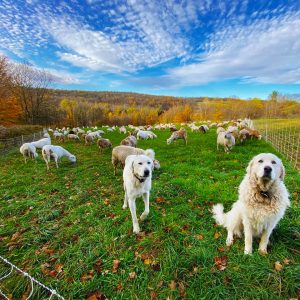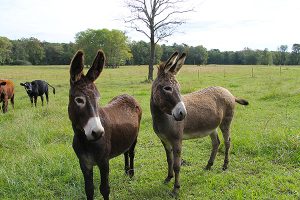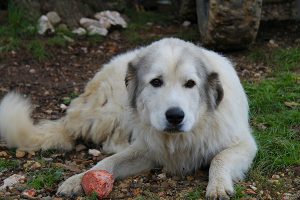Livestock Guardian Animals: Protecting the Flock or Herd
By Linda Coffey, NCAT Agriculture Specialist
You walk out to check your sheep and find the best lamb is missing. Your dairy goats go out to graze with their kids and return later without your daughter’s best show prospect. One day you come home to find that a dog has ravaged your animals, and the carnage is sickening.
How do you make sure this doesn’t happen on your farm?
Livestock Guardian Animals: Choosing a Good Protector

Photo: Courtesy of Lewis Fox, Fox Farms
If this is your concern, you are not alone. The American Sheep Industry Association (ASI) notes that predation is the leading cause of death in American sheep flocks. All of the above situations happened in our own flock, before we took actions to prevent predation.
A good fence can help and is an essential first step. Having at least some electrified wires that are powerful enough to get attention may deter dogs and coyotes. However, in areas with a lot of predator pressure, savvy predators may figure out how to avoid shocks. Once they do, the fence will not be sufficient protection. Also, a fence cannot protect from avian predators, such as eagles or turkey vultures.
Penning livestock near the house at night can help if predators are wary of humans. That strategy may leave the animals more prone to “little predators,” however, as internal parasites become a serious problem where animals camp and manure builds up. Also, the manure left in the lot is not helping the pastures. It’s much better to keep the animals on pasture when possible, so that their fertility can build soil.
This is where livestock guardians can show their value. By using livestock guardian animals, you can give your animals 24-hour-a-day bodyguards and allow the animals to stay out grazing and spreading manure on the land. Effective guardians prevent injuries and deaths and give the farmer peace of mind. They are well worth the cost.
On the other hand, not all livestock guardian animals are effective, and when they are not, they can cause losses and strain neighbor relations. So, how can you increase the odds of getting a good protector and not another problem? Following are strategies that can help set up a good situation.
Selection

Donkeys at The Farm at Barefoot Bend. Photo: Margo Hale, NCAT
- Choose the right animal for the terrain, predator pressure, pasture size, proximity to neighbors, budget, and your personal preference.
- Only use animals that have been bonded to the species they will protect. Bonding happens in the first weeks of life: for dogs, before they are 16 weeks old.
- Put an unfamiliar dog in the pen with a prospective guard donkey or guard llama to test them. If they don’t seem to notice, they are likely not a good guardian prospect. You want a guardian that is antagonistic toward strange canines. A donkey will show this by braying and moving toward the dog and attempting to stomp or kick it. Our donkey behaved like this to strange dogs but accepted our own dogs.
- Do not expect to get a good dog (or donkey or llama) for free; the animals that you want will have been raised on a farm with sheep (or goats, if that is what you raise). The dog you want should have been vaccinated, and those essential shots come with a cost. An animal that is not bonded to the stock may avoid associating with the stock and may injure or kill the stock rather than protecting them.
- Use the right number of guard animals. Using more than required is expensive and counter-productive. For example, one donkey that is bonded will associate with the sheep or goats. Three donkeys may choose to associate with each other instead.
- It is okay to combine different species of guardians. Llamas or donkeys can work well with guardian dogs, and this can be a kind of hedging. Llamas and donkeys live a long time, eat what the sheep or goats eat, and stay in the pasture where you put them. Dogs need special food, do not live as long, and are more mobile. If they roam, they may be shot or run over; that leaves your animals unprotected unless they also have a llama or donkey on the job.
- If you are getting a livestock guardian dog, be sure to choose a dog that is “all guardian”—both parents are the type of dog with the proper instincts. For example, a Great Pyrenees/Anatolian Shepherd cross may make a wonderful guardian. A Great Pyrenees/pit bull cross most likely will not.
- Choose a guardian animal that you enjoy. If you have never liked horses, then a donkey may not be the best choice for you.
Training

Photo: Linda Coffey, NCAT
- Dogs must be taught their territory and taught to stay with the flock or herd. This should be done when they first arrive at your farm. An electric fence will be a great help, and so will sharp correction and a temporary “timeout” if they do get out. Roaming is a habit that causes more losses of dogs than any other.
- Supervise any guardians during lambing or kidding, especially when they are young. Sometimes they have problems with “protecting” the babies from the mothers. Sometimes the dogs may want to help clean the babies, which is upsetting to the mothers and may result in accidental chewing (of ears or tails, for instance). You must correct any bad behaviors and may have to separate the guardians to the other side of the fence until they gain maturity. We have had two dogs that were problems their first kidding season; they were fine the next year and became very good guardians. Plan for your dogs not to mature until past 18 months of age, and be watchful.
- Count your animals so you will know immediately if you are missing any.
Care and Keeping

Photo: Linda Coffey, NCAT
- Spay or neuter the guardian animal to cut down on behavior issues. The exception would be if you are planning to breed the animals, of course. But you should never use an intact male donkey or intact male llama as a guardian. They often show aggression to the stock and perhaps to humans. Intact male dogs will be prone to wander, which leads to trouble with the neighbors. An intact female dog may allow a wandering male canine into the pasture if she is in heat.
- Plan to spend what it takes to keep healthy guardian animals. Estimate and figure into the budget costs for vaccinations, deworming, heartworm prevention meds, and flea and tick prevention for dogs, hoof care for donkeys and llamas, shearing for llamas (and perhaps for Great Pyrenees dogs), dental care for donkeys and perhaps llamas, and food for dogs. These are legitimate farm expenses and should be included in your farm records.
- Feed your dogs properly to keep them healthy.
- You must keep guardian dogs with the animals. It is okay to pet them; you need to be able to catch them, take them on a leash, get them yearly vaccinations, and feel safe with them. Having a dog that is friendly to you will not prevent them doing their job. Keeping them on the porch will.
- Talk to your neighbors about the guardian dogs. Be sure your dogs have identification so that if they do roam, someone can let you know. A roaming dog is a liability and in many situations will not be tolerated.
This all may seem like a lot to think about, but once these basics are in place, livestock guardian animals can be fairly trouble-free and real assets to the farm. They make it possible to raise small ruminants in a wildlife-friendly way, and to protect the livestock (and profits) from harm. We no longer lose animals—or sleep—to predators.
Further Resources
Livestock Guarding Dogs: Protecting Sheep from Predators, by Roger Woodruff and Jeffrey Green. USDA Bulletin 588.
This bulletin contains 32 pages of excellent information from two researchers who worked extensively with dogs at the U.S. Sheep Experiment Station in Dubois, Idaho. It has excellent information about livestock guardian dogs and how to train them and work with them, includes discussion of the breeds that are most common, and is useful to producers in all parts of the country.
Texas A&M Agri-Life Extension
A great source of information. Their research includes how best to bond pups to the stock. They also have GPS monitors that show how the dogs cover the territory. In addition, they have case studies and a blog all focused on the topic. Their research has proved that dogs are effective deterrents to predators, and they are coming out with more information to help producers be successful with dogs. They have a Facebook page, as well, and you can sign up for an email newsletter by going to the webpage..
Food Animal Concerns Trust (FACT)
FACT has a great library of webinars, including a five-part series about predator control and livestock guardian dogs by Janet Vorwald Dohner.
Books by Jan Dohner. Available from Storey Publishing.
Farm Dogs: A Comprehensive Breed Guide includes photos and descriptions of 93 guardians, herders, terriers, and other canine working partners. It’s a lovely book!
The Encyclopedia of Animal Predators is an excellent book for learning how to determine which predator is your problem, and how you might outwit it.
For more information about sheep and goats and other agricultural topics, visit the ATTRA Sustainable Agriculture website. Call 800-346-9140 to talk directly with an agriculture specialist. And you can email questions to me: lindac@ncat.org. Good luck in your endeavors!
Livestock Guardian Animals: Protecting the Flock or Herd
By Linda Coffey, NCAT Agriculture Specialist
Published April 2020 ©NCAT
IP599
Slot 624
This publication is produced by the National Center for Appropriate Technology through the ATTRA Sustainable Agriculture program, under a cooperative agreement with USDA Rural Development. ATTRA.NCAT.ORG.

